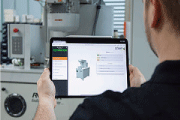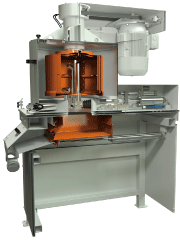Mass finishing is a rapidly evolving surface treatment method. From its “invention” as a simple system for the mechanical deburring of mass-produced parts in the 1950s, it has grown into a sophisticated surface refinement technology. Today, mass-finishing systems handle the most challenging finishing tasks in such diverse industries as aerospace, automotive, medical engineering, coin blanking, etc. And more recently, mass finishing has become a major surface-finishing method for 3D-printed components, so it is not surprising that the suppliers of mass-finishing systems are now actively pursuing the digitization of their products to further strengthen their customer support. In this article, we look at how a digital process water management system is helping companies utilizing centrifuges for cleaning and recycling the process water from mass-finishing operations to make this cleaning operation more efficient and more stable. The system monitors up to 13 different process parameters and initiates specific corrective actions whenever the values of these parameters are drifting out of an acceptable range.
Digitization – an essential tool for remaining competitive in a globalized world!
Digitization, frequently also called digital transformation, is a term that in recent years has become a call for streamlining industrial operations with the goal to make companies more efficient and help them thrive in an increasingly global competitive environment. Digitization is also frequently mentioned in conjunction with Industry 4.0. But what exactly is the meaning of digitization and what goals are pursued with it?
The goals of digitization?
In principle digitization is a technological trend from the analogue handling of data to processing it digitally. Of course, this trend from analogue to digital allows rapidly growing electronic communication among industrial processes and equipment through the “Internet of Things”.
Digitization is primarily focused on improving a company’s products and services with the goal to provide more benefits to the customers and, thus, become more competitive. Specifically, digitization includes:
Digital quality management during the manufacturing operation: For example, the use of certain algorithms can improve the performance and stability of manufacturing processes.
Machinery connectivity and the use of analytical tools: Interconnected machines will allow users and suppliers to quickly correct equipment problems on site or remotely.
Digitization in the machinery building industry
In the machinery building industry digitization includes, among other things, equipping the machines with all kinds of sensors and linking these to a computer. There, the respective sensor readings are evaluated by suitable software, which in turn provides a detailed analysis of the machinery functions and the physical condition of the machinery itself. This allows for the quick adjustment of the machine parameters before they might drift out of the acceptable range.
It also allows a predictive approach towards maintenance. The equipment is practically self-diagnosing and provides suggestions for overcoming detected problems. This helps save costs by preventing poor product quality and costly down-times or equipment crashes.
Why mass finishing processes are perfect for digitization?
A parameter-driven technology
Mass finishing is a highly empirical finishing method. The success or failure of the finishing process depends entirely on the optimal interaction of certain parameters, such as the grinding or polishing media, the compound, the process water, the settings of the finishing machine, the cleaning of the process water, etc. In practically all cases, these parameters are determined through elaborate processing trials. Once a process has been established, it is crucial for the personnel operating the equipment to maintain these parameters. Even the slightest variation, for example, a reduced compound and water flow, a too-low media level in the machine, plugged machine drains or a wrong motor speed, can quickly impair the finishing results. This can even lead to a point where the finished workpieces become scrap. Digitization can be a way out of this dilemma!
What are the advantages of digitized mass finishing operation?
By digitizing the control of the various process parameters, the vagaries of the human factor can be neutralized. In place of human operator evaluation, strategically placed sensors now monitor the parameters and report their readings to a computer. In turn, the computer analyzes the data, determines whether it is out of the specified range, and even makes specific proposals to remedy the situation.
This digitized approach allows the recognition and resolution of problems much more quickly, be it adjusting the dosing rate of the process water and compound, replenishing the media in the machine, or cleaning the machine drains....The result is a much more stable mass-finishing process that consistently produces the specified results.
Of course, the same digitized system also analyzes certain machine parameters like, for example, the condition of the wear lining, and provides valuable clues for “predictive” maintenance. Finally, the digital connectivity enables the supplier specialists to remotely evaluate the customer’s finishing operations in detail and instantly resolve problems without having to undertake time-consuming trips.
Case study – a digital process water management system for cleaning centrifuges
In a first step towards digitization, a global leader in the field of mass finishing and shot blasting developed a water management system process for controlling the operation of its cleaning centrifuges. The applied centrifugal force in these centrifuges cleans the “dirty” process water by separating solids like media and metal fines and, frequently, oil from the liquid. After it has passed through the centrifuge, the processed water is so clean that it can be recycled to the mass-finishing operation for re-use.
As simple as this sounds, the management of this cleaning process can be quite complicated. It requires controlling numerous operating parameters like, for example, the pH value of the processed water, the compound concentration, the water hardness, the chemical oxygen demand (COD), and the degree of bacterial infection... to name just a few. To date, all these parameters had to be controlled manually, and corrective action was left entirely to the personnel looking after the centrifuge cleaning process.
How does the water management system work?
In the “Advanced” version of this system, up to 13 process parameters are still measured by hand, but now they are entered into a computer for evaluation, and in turn, the computer provides a complete analysis of the parameter readings. Whenever a value is out of its specified range, the computer proposes detailed corrective action to be taken by the operating personnel.
In the “Comfort” version of the management system, available by the end of 2021, the manual measurement of the process parameters will be replaced to a large extent by suitable sensors. This allows the majority of the measurements to be taken fully automatically. Likewise, most of the proposed corrective actions do no longer have to be taken by hand but are also automated.
By 2022, the system will be available in a cloud-based version, allowing online access to the data from practically anywhere in the world. This will allow the specialists from the supplier to remotely assist the customer in trouble-shooting, and whenever the customer needs to change his process, for example, due to a changing product mix, the specialists can remotely assist with the adjustment of the water management system to the new situation without having to be on site.
The customer benefits
The new water management system provides numerous benefits to the customers. For example, they must no longer rely on the experience and knowledge – or lack thereof – of their people, but can resort to a computer system reflecting the comprehensive knowhow of the supplier. The quick discovery of out-of-range parameters keeps the water recycling and mass-finishing processes stable while preventing costly down-times. Costly external analysis of the processed water is no longer required because the system is self-diagnosing. Online access allows remote trouble-shooting and process adjustment by the supplier specialists while eliminating costly visits by the supplier’s process engineers.
Good Vibrations
by Eugen Holzknecht
Contributing Editor MFN and
Rösler Oberflächentechnik GmbH
E-mail: holzknecht.usa@gmail.com
































